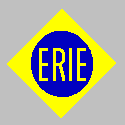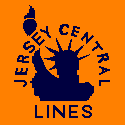History
of the Railroads Covered by the Society

The following railroads are covered by
the Society. Here is a brief history of each line:
New Jersey Midland Railroad
The New Jersey Midland traces its roots back to the
1830's when the first thoughts of building a railroad from the Paterson area to the coal fields around Scranton came about. Later the NJM was redirected to be part
of the New York & Oswego Midland, to link New York City with Lake Ontario at Oswego, NY (the NY&OM was originally going to reach New York via the New York & Greenwood Lake Railroad, but
money ran out before the missing link between Greenwood Lake
and Middletown, NY was even started). The NJM ran from the Pennsylvania
Railroad at Jersey
City to the
NJ/NY border at Unionville. The 13 mile Middletown, Unionville & Water Gap was leased to reach the
New York & Oswego Midland at Middletown, NY. As it turned out, Buffalo became the major great lake city, not Oswego and both companies collapsed in the Panic of 1873.
After the bondholders slugged it out in court, the NJM again became independant and resumed the quest to reach the coal fields.
In 1881 the NJM and its affiliates merged to become the New York, Susquehanna & Western
New York, Susquehanna & Western Railroad

The New York, Susquehanna & Western reached Stroudsburg, PA in 1882, the old Midland route from the main line at Beaver Lake, NJ to Middletown became a branch (cut back to the state line when the
Middletown, Unionville & Water Gap lease was dropped in
1913). At Stroudsburg the NYS&W received coal from the Lackawanna (DL&W). In 1892 the NYS&W decided to reach
the coal fields directly and began construction of the Wilkes Barre & Eastern and the Susquehana
Connecting RR to directly reach the Wyoming Valley anthracite coal. The new line was highly profitable and caused pricing
chaos among the older anthracite roads. In 1898, J.P. Morgan bought control of
the NYS&W and leased it to the Erie. The NYS&W functioned as part of the Erie until 1937 when bankruptcy resumed independant operations and at the same time caused the
abandonment of the Wilkes Barre & Eastern. Independance brough many changes:
the first class one railroad to completely dieselize (with Alco RS-1s and
S-2s), ACF railcars for the commuter runs from Paterson to a bus transfer via
the Lincoln Tunnel into New York, and abandonment of the line between
Stroudsburg, PA and Hainesburg Jct., NJ. In the early
1950s the line was somewhat prosperous with more diesels and Budd RDCs for passengers. At Edgewater, NJ there was the unique Seatrain
operation that provided direct interchange to Gulf ports. In 1958 the NYS&W's fortunes declined: the branch to Unionville was
abandoned, the RDCs sold off, maintenance reduced to
a minimum. In 1962 all track west of Sparta Jct., NJ was abandoned. In 1966 the
last commuter service to Butler
ended. In 1969 an unsafe bridge in Sparta embargoed the line between the Wharton &
Northern at Green Pond and the Lehigh & Hudson River at Sparta Jct. A
washout in 1971 closed the line west of Butler. The NYS&W was again bankrupt in 1976 and near
abandonment in 1980 when purchased by the Delaware Otsego Corp. By 1986 the
NYS&W aquired the former Lackawanna branches from Binghamton, NY to Utica and Syracuse and the L&HR from Sparta Jct. to Warwick, NY. The line between Butler and Sparta Jct. was rebuilt. Today, the NYS&W
runs double stack container trains over its lines as the eastern link for
containers from ports on the west coast. RDC service is provided in Syracuse and commuter trains are slated to run from Sparta to Hoboken in 2000. How the NYS&W change as a result of the
breakup of Conrail is uncertain at this time.
Wilkes Barre & Eastern Railroad
The Wilkes Barre &
Eastern was built beginning in 1892 from the NYS&W at Stroudsburg, PA to Wilkes Barre. At the
same time the Susquehanna Connecting RR was built from the WB&E at Suscon north to the various independent mines and breakers.
Passenger service began with two through trains from Jersey City. By 1904 service was down to one mixed train a day
between Stroudsburg and Plains (3 miles short of Wilkes Barre).
The 1898 takeover of the NYS&W by J.P. Morgan and the Erie eventually diverted the coal traffic off the line.
The 1937 bankruptcy of the NYS&W also disavowed the lease which had kept
the WB&E afloat. The WB&E was abandoned in 1939 but the bankruptcy
proceedings would drag on for nearly 20 years. Parts of the Susquehanna
Connecting Railroad survive today run by Conrail and several shortlines.

The Lehigh & Hudson River began as a small line,
the Warwick Valley Railroad that connected the town of Warwick, NY with the Erie at Greycourt, NY. The line expanded south into New Jersey, and in 1882 the Warwick Valley and its affiliates merged to become the L&HR. The line extended
from Belvidere, NJ to Maybrook, NY where the New Haven Railroad provided a gateway to New England. The L&HR built a bridge between Phillipsburg, NJ and Easton, PA and ran via trackage
rights on the Pennsylvania RR and the Jersey Central Railroad to Allentown, PA. The L&HR handled zinc traffic from the area
around Franklin, NJ but mostly it was a bridge line carrying overhead
freight. The mergers and abandonments of the 1960 did
the L&HR harm, but the New York Central - PRR merger in 1968 caused much
traffic to be diverted. The line went bankrupt in 1972 and inclusion in Conrail
spelled the end in 1976. The line north of Sparta Jct. became part the the NYS&W main line in 1982 and the line south of that
point was abandoned by Conrail in 1986.
Lehigh & New England Railroad
The Lehigh & New England received its name in 1905
after the predecessor company, the Pennsylvania, Poughkeepsie & Boston, was aquired by the Lehigh
Coal & Navigation company. There was a line out to
the Lehigh River and Hauto that brought in
coal traffic and a line to Nazareth
and Martins Creek, PA for the cement industry. The line connected to the
NYS&W at Hainesburg Jct. and had trackage rights for about 20 miles to Swartswood
Jct., NJ. The line entered New York
at Pine Island and used trackage rights from there over the Erie to reach the New Haven at Maybrook. Traffic
declined through the 1950's and on October 31, 1961 the L&NE simply shut down. Some of the trackage for the cement industry centered around Bath, PA was purchased by the Jersey Central and some in Pen Argyl, PA by the Erie Lackawanna, but the rest of the line
was abandoned. View map
New York & Greenwood Lake Railway

The New York & Greenwood Lake Railway had a long
and involved history that will be updated at a later date. The line was
controlled by the New York & Oswego Midland and was intended to link the Midland Route to the Hudson River and New York City. The line was poorly built and had cost much more
than planned. The line between Greenwood Lake
and Middletown, New
York would
have required a tunnel under Sugar Loaf Mountain and was never built. The
collapse of the NY&OM also doomed the NY&GL to bankruptcy. The line ran
from the Erie at Jersey City through Montclair and on to Greenwood Lake
at the New
York State line at Sterling Forest. There were three branches: the Orange Branch to West Orange, the Caldwell Branch to Essex Fells and a connection
with the Morristown & Erie, and the Ringwood Branch to Ringwood. After the Midland Route dream was dead the line reorganized as an independant line under the control of the great iron
industry families of Hewitt and Cooper. The line provided steamboat service
with several ships to the hotels and docks on Greenwood Lake
via the Greenwood Lakes Transportation Company. Eventually the line was
absorbed into the Erie. Passenger service to the Lake ended in 1935. Commuter service continued to Wanaque-Midvale until
1966. Today everything north of the connection with the NYS&W at Pompton
Jct. and all three branches with the exception of the first half of the Orange branch are gone. The line spent most of its life as branch of the Erie and Erie Lackawanna, today the part south of Wayne is part of NJ Transit's Booton
line and north of there is the NYS&W's Pompton
Branch. Recently, approval was granted fo
the "Montclair Connection" which will connect the Greenwood Lake
line with the Lackawanna's Montclair Branch. This will probably result in
abandonment of the easternmost part of the line.

The Society is working towards a book on the history
of the Hoboken Shore Railroad. For photos and history, visit the Hoboken Shore Railroad Page
Middletown & New Jersey Railway
The Middletown & New Jersey began as the Middletown, Unionville & Water Gap and was originally built
to connect the town of Unionville,
New York to the Erie at Middletown, New York. The line opened in 1868 under lease to the Erie which operated it as its Unionville Branch. In 1872,
the MU&WG was leased by the New York & Oswego Midland to fill the
missing link to the New Jersey Midland. After the collapse of the Midland system, the MU&WG would be leased by the NYS&W until 1913 when
the line was reorganized as the Middletown & Unionville. The M&U
operated as an independent shortline between
connections with the Erie and Ontario & Western at Middletown and the NYS&W at M&U Junction, below
Unionville. In 1947 the line was reorganized as the Middletown & New Jersey
Railway. In 1957, the M&NJ lost one of its connections at Middletown as the O&W was abandoned; in 1958 the southern
connection was lost as the NYS&W abandoned its Hanford Branch. Today the
M&:NJ operates 5.5 miles between Middletown and Slate Hill while the
remaining 9 miles between Slate Hill and Unionville have been out of service
for a number of years.
In addition to our coverage of the
Middletown & New Jersey and its predecessors, we are closely linked with
the Middletown & New Jersey Railroad Historical Society, which is dedicated
specifically to the M&NJ and its predecessors.
Middletown
& New Jersey Railway Historical Society
Wharton & Northern Railroad

The Wharton & Northern ran between the CNJ High
Bridge Branch near Lake
Jct., NJ to a connection with the NYS&W at Green Pond,
NJ. Originally the line was owned by the industries it served around Wharton, NJ but by the 1920's the line was controlled by the
CNJ. The junction at Green Pond was a major interchange point between the CNJ
and the Susquehanna. In 1958 the City of Newark built a new reservoir caused the W&N to be
relocated at the north end to a new connection with the NYS&W near Newfoundland. After the NYS&W embargoed the line in 1972, the
W&N stopped running north of Picatinney Arsenal.
By 1976 the line north of there was torn up. Today the remainer
of the line is still in place but out of service.
![]()




